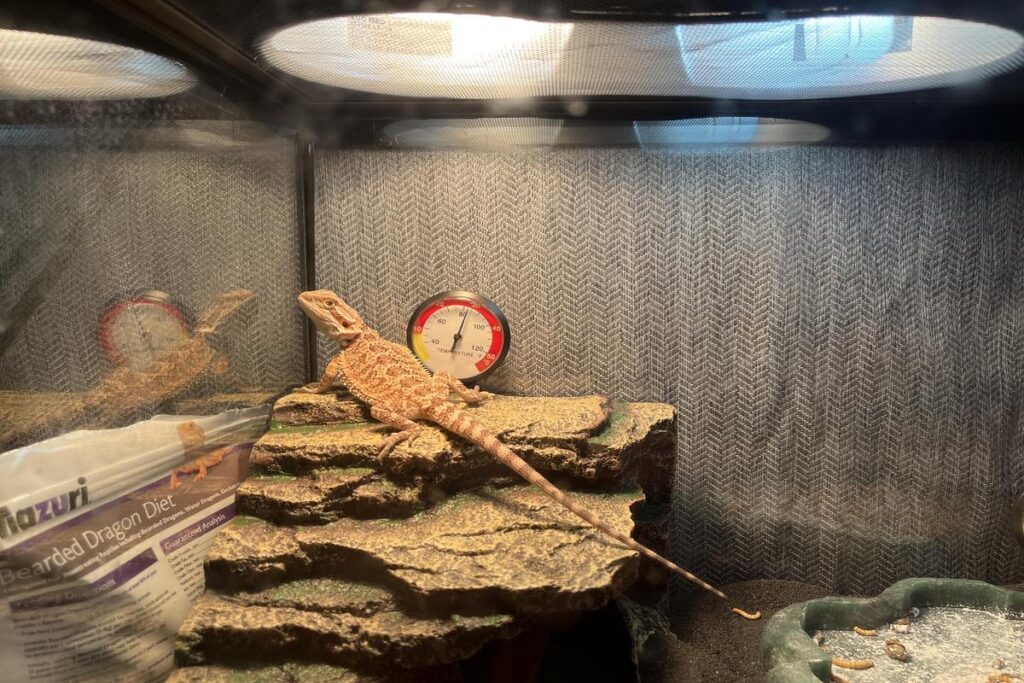They are cold blooded and need to bask to eat and digest food and survive. If your basking Temps to low (less than 95-110f) they may bask longer trying to get their Temps up .
What Does It Mean When A Lizard Is Basking?
Basking is common to most active diurnal reptiles. Lizards, crocodiles, terrapins, and snakes routinely make use of the morning sun to raise their body temperature. Freshwater turtles and terrapins have been found to bask and raise their body temperature close to the highest temperatures that they can tolerate.
Can A Lizard Get Too Hot?
Ectotherms (the name for ectothermic animals like most fish, reptiles, and amphibians) don’t always want or need to be hot to live their lives and can overheat just like mammals like humans can if they can’t escape extreme temperatures.
What Does It Mean When A Lizard Basks In The Sun?
Lizards and other cold-blooded critters bask in the sun to keep warm. But they also do it for the vitamin D, anew study finds. “It’s alongstanding assumption that thermoregulation is the only reason that lizards bask,” said study leader Kristopher Karsten, abiologist at Texas Christian University.
How To Tell If A Lizard Is Overheating?
Some symptoms of overheating in reptiles are visible burns on the body, listlessness, exhaustion, lethargy, less or no appetite and sitting with the mouth open. Some reptiles lie listless in the corner of the terrarium, while inhabitants of high terrariums go to the lower level.
How Do You Cool Down A Lizard?
Ju st li ke us , Re pt il es ca ng et to ow ar m ! Is it re al ly to ow ar m ?
Th ef ir st th in gy ou ne ed to do is ma ke su re it re al ly is to ow ar m . . . . Fr es hw at er . . . . Fa n . . . . Im pr ov et he ve nt il at io n . . . . Ic ec ub es . . . . Fr oz en wa te rb ot tl e . . . . Co ol ti le . . . . Re du ce th eh ea tc om in gi n .
Do Lizards Like Dark Or Light?
Lizards like dark places such as inside of cabinets, behind wardrobes and furniture. So, make sure you clean and air out these places regularly.
Do Lizards Need Sunlight?
Why do reptiles need UV light?
Ultraviolet (UV) light is necessary for reptiles to manufacture vitamin D3, which is required for the intestines to successfully absorb calcium from food. Diurnal wild reptiles typically spend many hours aday basking in the sun, absorbing this light.
How Do You Know If A Lizard Is Too Cold?
Signs of hypothermia in reptilesLess movement and activity – they may even become motionless.Reluctance to eat and drink.Eyes may appear sunken due to dehydration and weight loss.Skin may become more wrinkled.Their skin won’t shed properly and may become patchy due to the dehydration.
Do Lizards Prefer Hot Or Cold?
Cold blooded animals are much more active in warm environments and are very sluggish in cold environments. This is because their muscle activity depends on chemical reactions which run quickly when it is hot and slowly when it is cold. This is why we see lizards mostly in summers.
How Do Lizards Show Affection To Humans?
Lizards actually can be quite affectionate. Many appear to enjoy cuddling or sitting on their humans, and some even become lap lizards. However, some of these tiny dinosaurs only feel comfortable being handled or petted by their owners. Don’t expect too much from astrange reptile.
How Do You Know If A Lizard Is Thirsty?
He lp ! IT hi nk My Re pt il eI sD eh yd ra te d ! Dr y , wr in kl ed or pu ck er ed sk in . Lo ss of sk in el as ti ci ty an df le xi bi li ty . Su nk en , re ce de de ye s . We ak ne ss an dl et ha rg y . St ic ky or dr ym em br an es . Fl ak ys ki no rt ro ub le sh ed di ng . Co ns ti pa ti on or in fr eq ue nt de fe ca ti on .
What Calms Lizards?
Calming Wipes – Wipe the inside of vivarium glass. Gently wipe under chin of reptiles to help with bonding. Plug Diffuser – Use in the same room as your vivarium to allow constant slow release of low concentration actives into the surrounding area.
How Do You Calm A Stressed Lizard?
Always keep their head pointed away from your body and face. If you need additional help to keep your pet calm, consider using natural calming products. They help stressed pets be calmer, attentive, and receptive to their owners without sedating them.
What Is An Abnormal Lizard Behavior?
Reptiles who are not adapting well display arange of abnormal behaviours, including: Hyper‐vigilance. Inflation of the body. Escape attempts e.g.
, rubbing their face on the enclosure sides (you may see resulting abrasions on the front end of the reptile’s body)
What Do Lizards Do When It Gets Hot?
Lizards, for example, must move in and out of shade to maintain abody temperature that allows them to move quickly and helps them digest their food.
Do Lizards Need Heat At Night?
Every reptile or amphibian species has different heating requirements and always need awarm-side and acool-side during the day and at night.
This helps them regulate their temperatures appropriately so they can be happy, healthy, and active!
How Hot Is Too Hot For A Lizard?
Temperatures above 95°F (35°C) can be too hot for many species of geckos and may lead to heat stress, dehydration, and other health issues. It’s essential to monitor the temperature in their enclosure using athermometer and adjust the heating elements accordingly to ensure they stay within the appropriate range.
How Do You Know If A Lizard Is In Pain?
The British Small Animal Veterinary Association has also documented general signs of pain in reptiles including anorexia, immobility, abnormal posture/locomotion, dull colouration, and increase in aggression (Brown and Pizzi, 2012).
How To Cool Down A Lizard Tank?
Ice. If you have alarge water bowl you can float ice in it – the cool water will help to reduce very high temperatures. This does not last very long, however; you can use freezer blocks instead. Just try and make sure that there can be no contact between your pet and the ice/freezer block.
What Happens If A Lizard Is Cold?
However, when it gets below 45 degrees, lizards get so cold that they lose the ability to move their limbs. Then, if the tree branch moves, they fall to the ground. While the fall may cause the lizard to die, they are usually not dead when they fall. And unless it gets below freezing, they aren’t frozen either.
How Do You Warm Up A Cold Lizard?
When the reptile is dry, wrap it in awarmed towel and place it on ahuman heating pad in its enclosure or basking area.
What Smell Do Lizards Hate?
Fill small, porous sachets with scents that lizards hate, such as garlic, coffee, tobacco, or chili powder. Place them around your home.
Why Do Lizards Bask?
Reptiles are ectotherms, making them dependent on the warmth produced by the sun and their environment for internal temperature regulation. For reptiles, a comfortable and functional body temperature is managed by instincts that draw them to bask in the heat or retreat to acooler place.
Do Lizards Need To Bask?
Vitamin Dis an essential nutrient for all vertebrate species, and sunshine is the major source for most lizards. Their diet of insects doesn’t provide enough vitamin D, so they depend on basking to provide it. In fact, scientific studies have shown that lizards bask longer when their bodies are deficient in vitamin D.
What Happens When A Lizard Gets Too Hot?
Reptiles such as lizards and snakes are especially susceptible to heat and can die after only afew hours’ exposure to hot summer sun; these animals seek shelter under rocks and in burrows. Turtles, which also are reptiles, will go into deeper water during heat waves.
At What Temperature Are Lizards Most Active?
At night, sprint speeds were higher at 20 and 35 °C but sprint speeds were similar at 25 and 30 °C. By day, sprint speed increased with body temperature, peaking at 30 °C, before declining at 35 °C. However, gecko speeds over 1 mwas higher at night at all four test temperatures than by day.
Can Lizards Sense Temperature?
Yes and no. Reptile skin senses temperature differently from ahuman’s. While they can sense sudden, significant temperature changes (touching avery hot or very cold object) and react appropriately, they can’t sense their skin slowly warming or cooling.
How Do Lizards React To Heat?
Reptiles, such as this lizard, are “cold-blooded” and cannot create their own body heat. Movement is not the only body function that can change with the temperature. Digestion is another good example. Lizards will move back and forth between the sun and shade to keep their bodies around acertain temperature.



